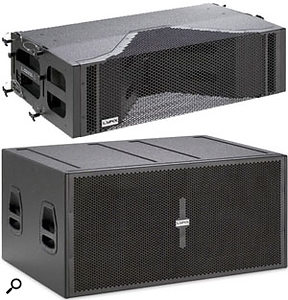
If you were at this year's Glastonbury and liked the sound from the Park Stage, then the people to thank (aside from the sound company, of course, the Bristol-based South West Group) are the Spanish audio specialists VMB, whose Lynx V8 line array system has been winning a lot of friends in recent months.
But VMB aren't resting on their laurels, hence the introduction of the LX-V8 — a compact, powered, two-way line array module featuring a built-in inclinometer.
For lovers of in-depth tech detail, the LX-V8 is pretty cutting edge, featuring two slot-loaded neodymium magnet transducers, deployed in a V-type topology. The cones and suspensions are constructed of Nomex, the high-temperature material used in fire fighting, while for high frequencies, two neodymium-magnet drivers are individually coupled to cast-aluminium plane wave adaptors, to increase driver heatsinking and reduce power compression.
A total of 2500W of Class-D amplification is utilised: a 1000W amplifier for each of the LF drivers, plus a 500W one for the HF unit. The switched-mode power supply eases cooling requirements, VMB say, while reducing box weight to a reasonable 42kg — including the integral flyware. In addition, the LX-V8's electronics feature a DSP processor that provides equalisation, filtering, alignment and dual-mode (RMS and peak) compression, protecting from thermal as well as mechanical driver damage. An LCD display provides readout of the pitch angle as well as the temperature of the hottest amplification element. To compensate for array size, users enter the number of boxes using push locations integrated into the screen. The system then automatically applies inclinometer data (which is only read at power-up to avoid movements of the array from affecting the processing) to calibrate box throw to long, medium or short. For non-standard setups, this can also be defined manually. For added flexibility in complex applications, corrections for box throw and array elements can be bypassed and performed by an external processor.
The high-precision inclinometer is not a mere gimmick, says VMB's R&D director Carlos Matal. The angle information is fed to the processor and the signal conditioning algorithms are changed accordingly. In the pipeline, he adds, are further advanced uses for that data within a network of array modules.
Yes, it's high-end stuff, but we expect to see the usual trickle-down effect of this technology over the next few years.
VMB +34 961 221 521
